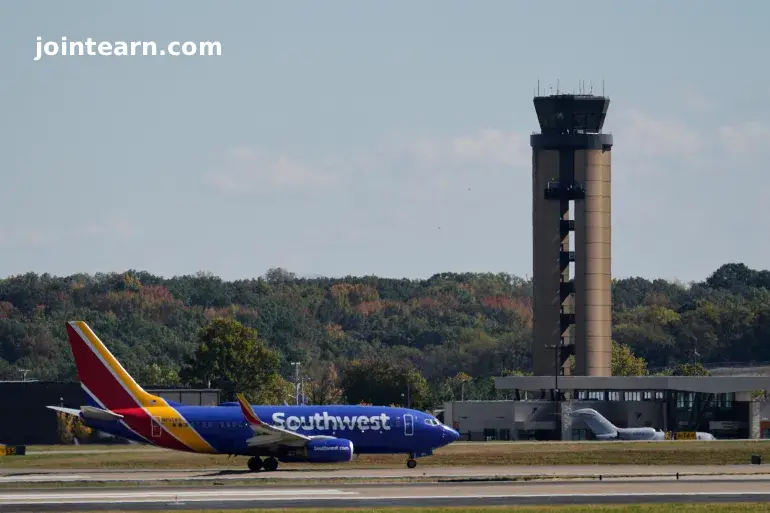
FAA Orders Nationwide Flight Reductions Due to Controller Shortage
The Federal Aviation Administration (FAA) has ordered airlines across the United States to reduce air traffic by 10 percent at the nation’s 40 busiest airports, citing severe staff shortages among air traffic controllers caused by the ongoing US government shutdown.
The unprecedented move has already led to the cancellation of hundreds of flights, disrupting travel for thousands of passengers ahead of the busy holiday season.
According to FlightAware, a leading flight-tracking platform, more than 790 flights were cancelled on Friday, with another 500 cancellations already listed for Saturday. Industry analysts warn that these numbers are expected to rise sharply as the FAA’s phased cuts take effect over the next week.
FAA: Safety Comes First as Shutdown Strains Air Operations
In an official statement issued Thursday, the FAA said it was forced to act after mounting reports of fatigue, stress, and absenteeism among air traffic controllers — many of whom have been working without pay for over five weeks due to the record-breaking federal shutdown.
“Since the beginning of the shutdown, controllers have been working without pay,” the FAA said in its order.
“This has resulted in increased reports of strain on the system from both pilots and air traffic controllers.”
The agency cited a spike in operational delays last weekend — 2,740 flight delays across major hubs — as evidence that the system was reaching its limits.
The FAA emphasized that the decision to reduce air traffic was purely a safety precaution, not a political maneuver.
Transportation Secretary: ‘This Is About Safety, Not Politics’
US Transportation Secretary Sean Duffy defended the move as a necessary measure to prevent accidents and maintain aviation safety standards amid unprecedented strain on the aviation system.
“My department has many responsibilities, but our number one job is safety,” Duffy told reporters.
“This isn’t about politics – it’s about data and risk management. It’s safe to fly today, and it will continue to be safe next week because of these proactive steps.”
Under the FAA’s phased plan, air traffic volume will be reduced by 4 percent on Friday, gradually increasing to 10 percent by November 14. Airlines have been instructed to prioritize domestic flight cuts, while international routes will remain at the discretion of each carrier.
Major US Airports Impacted by FAA Cuts
The FAA’s reduction order affects 40 of the nation’s largest airports, including some of the busiest hubs in the world. Among those directly impacted are:
- Hartsfield-Jackson Atlanta International Airport (ATL)
- Dallas-Fort Worth International Airport (DFW)
- Denver International Airport (DEN)
- Chicago O’Hare International Airport (ORD)
- John F. Kennedy International Airport (JFK) in New York
Other major hubs — including Los Angeles, Miami, Charlotte, and Seattle — are expected to see ripple effects in the coming days as airlines reconfigure schedules.
FAA Administrator Bryan Bedford said the agency “will not hesitate to take further action” if the situation worsens, suggesting deeper flight cuts could be considered should the shutdown persist.
The Impact of the Government Shutdown on Air Travel
The US government shutdown, now entering its 38th day, has caused widespread disruption across federal services.
The stalemate in Congress between Republicans and Democrats over government funding and healthcare spending has left federal workers unpaid and many agencies short-staffed.
According to the Bipartisan Policy Center, approximately 730,000 “essential” federal employees — including air traffic controllers, TSA screeners, and border agents — continue to work without pay. Another 670,000 federal employees have been furloughed, halting non-essential services nationwide.
The FAA employs just over 14,000 certified air traffic controllers nationwide. Under normal conditions, the agency operates on tight staffing margins; even a small percentage of absences can severely disrupt airspace management.
Aviation safety experts have long warned that the US air traffic control system was already understaffed and aging, making it especially vulnerable during prolonged government shutdowns.
Travel Disruptions and Passenger Frustration Grow
Airlines and passengers alike are bracing for widespread delays and cancellations as the FAA’s order takes effect.
Travelers have taken to social media to express frustration over the lack of clarity from airlines, many of which are still adjusting schedules to comply with the 10 percent reduction mandate.
Delta Air Lines, American Airlines, and United Airlines have each issued statements pledging to accommodate affected passengers and waive change fees for flights canceled due to the FAA directive.
“We understand this is an evolving situation,” a Delta spokesperson said. “Our teams are working around the clock to rebook passengers and minimize disruption.”
Industry analysts estimate that daily cancellations could exceed 1,000 flights if the FAA extends restrictions or if controller absences increase further in the coming week.
Economic and Political Fallout Looms
The FAA’s order adds pressure on Senate Democrats, who have been blocking the latest government spending bill in protest over proposed cuts to healthcare funding.
Republicans, meanwhile, accuse the Biden administration of weaponizing safety regulations to force Congress into action — an accusation Transportation Secretary Duffy has strongly denied.
Economists warn that a prolonged shutdown could cost the US aviation sector hundreds of millions of dollars, especially if disruptions continue into the Thanksgiving travel rush, one of the busiest travel periods of the year.
“If the shutdown continues into late November, the economic fallout could be severe,” said Michael Boyd, president of the Boyd Group aviation consultancy.
“Flight cancellations will ripple through logistics, tourism, and business travel, compounding the financial hit to the economy.”
Looking Ahead
While the FAA insists the skies remain safe, the combination of overworked staff, unpaid essential employees, and mounting political deadlock threatens to deepen America’s air travel crisis.
For now, passengers are advised to check flight status regularly, arrive early at airports, and prepare for delays as the aviation system adapts to a reduced-capacity schedule.
Key Takeaways
- FAA orders a 10% cut in US air traffic due to controller shortages
- Hundreds of flights cancelled nationwide, with numbers expected to rise
- Government shutdown enters 38th day, leaving 1.4 million federal employees unpaid or furloughed
- Safety cited as the top priority by the FAA and Transportation Department
- Airlines brace for more disruptions ahead of Thanksgiving travel season


Leave a Reply